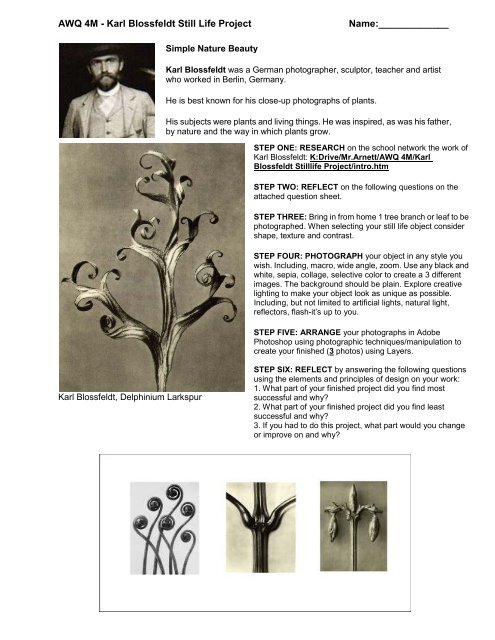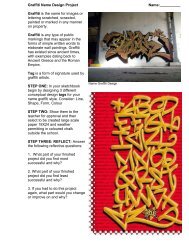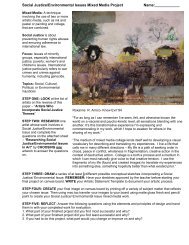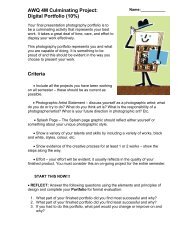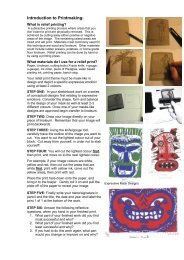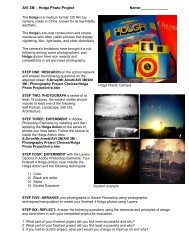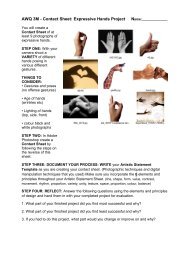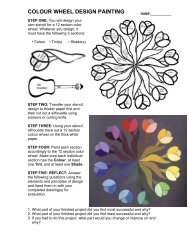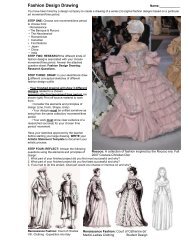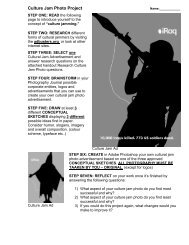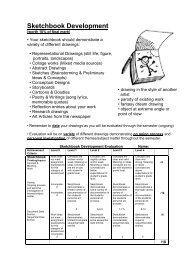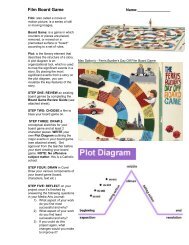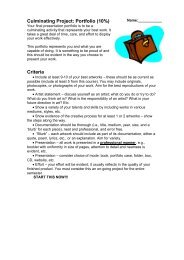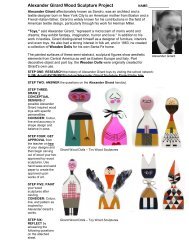Karl Blossfeldt Stilllife Project
Karl Blossfeldt Stilllife Project
Karl Blossfeldt Stilllife Project
Create successful ePaper yourself
Turn your PDF publications into a flip-book with our unique Google optimized e-Paper software.
AWQ 4M - <strong>Karl</strong> <strong>Blossfeldt</strong> Still Life <strong>Project</strong><br />
Name:_____________<br />
Simple Nature Beauty<br />
<strong>Karl</strong> <strong>Blossfeldt</strong> was a German photographer, sculptor, teacher and artist<br />
who worked in Berlin, Germany.<br />
He is best known for his close-up photographs of plants.<br />
His subjects were plants and living things. He was inspired, as was his father,<br />
by nature and the way in which plants grow.<br />
STEP ONE: RESEARCH on the school network the work of<br />
<strong>Karl</strong> <strong>Blossfeldt</strong>: K:Drive/Mr.Arnett/AWQ 4M/<strong>Karl</strong><br />
<strong>Blossfeldt</strong> <strong>Stilllife</strong> <strong>Project</strong>/intro.htm<br />
STEP TWO: REFLECT on the following questions on the<br />
attached question sheet.<br />
STEP THREE: Bring in from home 1 tree branch or leaf to be<br />
photographed. When selecting your still life object consider<br />
shape, texture and contrast.<br />
STEP FOUR: PHOTOGRAPH your object in any style you<br />
wish. Including, macro, wide angle, zoom. Use any black and<br />
white, sepia, collage, selective color to create a 3 different<br />
images. The background should be plain. Explore creative<br />
lighting to make your object look as unique as possible.<br />
Including, but not limited to artificial lights, natural light,<br />
reflectors, flash-it’s up to you.<br />
STEP FIVE: ARRANGE your photographs in Adobe<br />
Photoshop using photographic techniques/manipulation to<br />
create your finished (3 photos) using Layers.<br />
<strong>Karl</strong> <strong>Blossfeldt</strong>, Delphinium Larkspur<br />
STEP SIX: REFLECT by answering the following questions<br />
using the elements and principles of design on your work:<br />
1. What part of your finished project did you find most<br />
successful and why?<br />
2. What part of your finished project did you find least<br />
successful and why?<br />
3. If you had to do this project, what part would you change<br />
or improve on and why?
Artwork Title:__________________________________________Name:____________<br />
A) Influences from past and present works:<br />
K:Drive/Mr.Arnett/AWQ 4M/<strong>Karl</strong> <strong>Blossfeldt</strong> <strong>Stilllife</strong> <strong>Project</strong>/intro.htm<br />
1. How has <strong>Karl</strong> <strong>Blossfeldt</strong> used line in his work?<br />
2. How has <strong>Karl</strong> <strong>Blossfeldt</strong> photographed his still life object(s) in an interesting and unique<br />
way?<br />
3. What about <strong>Karl</strong> Blossfeld’s still life photography that makes it appear timeless in nature?<br />
4. What kind of mood/feeling do you get from <strong>Karl</strong> Blossfeld’s still life photographs and why?<br />
B) Photographic/digital manipulation techniques used in my work and how they support<br />
my intended visual message:<br />
C) REFLECT on your completed work by answering the following questions using the<br />
elements and principles of design:<br />
1. What part of your finished project did you find most successful and why?<br />
2. What part of your finished project did you find least successful and why?<br />
3. If you had to do this project, what part would you change or improve on and why?
<strong>Karl</strong> <strong>Blossfeldt</strong> Still Life Rubric<br />
Name:__________<br />
Knowledge/<br />
Understanding<br />
Demonstrates<br />
understanding of the<br />
elements &<br />
principles of design<br />
in the object mosaic<br />
photograph<br />
Level 0 Level 1 Level 2 Level 3 Level 4<br />
Work does not<br />
meet<br />
assignments<br />
expectations for<br />
this category.<br />
Incomplete.<br />
0<br />
Student<br />
demonstrates<br />
limited<br />
understanding of<br />
the elements &<br />
principles of<br />
design in the<br />
photograph.<br />
0.25<br />
Student<br />
demonstrates<br />
some understanding<br />
of the elements &<br />
principles of design<br />
in the photograph.<br />
0.50<br />
Student<br />
demonstrates<br />
considerable<br />
understanding of the<br />
elements &<br />
principles of design<br />
in the photograph.<br />
0.75<br />
Student<br />
demonstrates<br />
a high degree of<br />
understanding of<br />
the elements &<br />
principles of<br />
design in the<br />
photograph.<br />
1<br />
/1<br />
Thinking/<br />
Inquiry<br />
<strong>Karl</strong> <strong>Blossfeldt</strong> 3 Still<br />
Life photographs<br />
Work does not<br />
meet<br />
assignments<br />
expectations for<br />
this category.<br />
Incomplete.<br />
0<br />
Student depicts<br />
object in<br />
photographs with<br />
limited<br />
effectiveness.<br />
0.25<br />
Student depicts<br />
object in<br />
photographs with<br />
some effectiveness.<br />
0.50<br />
Student depicts<br />
object in<br />
photographs with<br />
considerable<br />
effectiveness.<br />
0.75<br />
Student depicts<br />
object in<br />
photographs with<br />
a high degree of<br />
effectiveness.<br />
1 /1<br />
Communication<br />
Clarity:<br />
Discusses artistic<br />
influences and<br />
research questions<br />
in the artistic<br />
statement<br />
Explains use of<br />
photographic/digital<br />
manipulation<br />
techniques in the<br />
artistic statement<br />
Reflective<br />
Questions: Strength,<br />
Weakness & Next<br />
Step<br />
Work does not<br />
meet<br />
assignments<br />
expectations for<br />
this category.<br />
Incomplete.<br />
0<br />
Incomplete.<br />
0<br />
Incomplete.<br />
0<br />
Student<br />
discusses<br />
influences in the<br />
artistic statement<br />
and research<br />
questions with<br />
limited clarity.<br />
0.25<br />
Student explains<br />
use of<br />
photographic<br />
techniques in the<br />
artistic statement<br />
with limited<br />
clarity.<br />
0.25<br />
Poor, yes/no<br />
answers/limited<br />
incomplete.<br />
0.25<br />
Student discusses<br />
influences and<br />
research questions<br />
in the artistic<br />
statement with some<br />
clarity.<br />
0.50<br />
Student explains<br />
use of photographic<br />
techniques in the<br />
artistic statement<br />
with some clarity.<br />
0.50<br />
Somewhat coherent<br />
and somewhat<br />
complete.<br />
0.50<br />
Student discusses<br />
influences and<br />
research questions<br />
in the artistic<br />
statement with<br />
considerable clarity.<br />
0.75<br />
Student explains<br />
use of photographic<br />
techniques in the<br />
artistic statement<br />
with considerable<br />
clarity.<br />
0.75<br />
Clear and<br />
substantial answers.<br />
0.75<br />
Student<br />
discusses<br />
influences and<br />
research<br />
questions in the<br />
artistic statement<br />
with a high<br />
degree of clarity.<br />
1<br />
Student explains<br />
use of<br />
photographic<br />
techniques in the<br />
artistic statement<br />
with a high<br />
degree of clarity.<br />
1<br />
Superior and<br />
insightful<br />
answers.<br />
1<br />
/1<br />
/1<br />
/1<br />
Application<br />
Creative Process:<br />
Creative Process:<br />
Demonstration of<br />
Skill Development &<br />
following procedures<br />
including Clean Up<br />
Incomplete.<br />
0<br />
Student<br />
demonstrates<br />
limited<br />
effectiveness in<br />
demonstrating the<br />
creative process<br />
and following<br />
procedures.<br />
5<br />
Student<br />
demonstrates some<br />
effectiveness in<br />
demonstrating the<br />
creative process and<br />
following<br />
procedures.<br />
5-6<br />
Student<br />
demonstrates<br />
considerable<br />
effectiveness in<br />
demonstrating the<br />
creative process and<br />
following<br />
procedures.<br />
7-8<br />
Student<br />
demonstrates<br />
superior<br />
effectiveness in<br />
demonstrating the<br />
creative process<br />
and following<br />
procedures.<br />
8- 10<br />
/10<br />
Uses elements &<br />
principles of design<br />
and photographic/<br />
digital manipulation<br />
techniques to<br />
produce an effective<br />
3 object<br />
photographs<br />
Incomplete.<br />
0<br />
Student<br />
demonstrates<br />
limited use of the<br />
elements &<br />
principles of<br />
design and<br />
photographic<br />
techniques to<br />
produce an art<br />
work of limited<br />
effectiveness.<br />
1<br />
Student<br />
demonstrates some<br />
use of the elements<br />
& principles of<br />
design and<br />
photographic<br />
techniques to<br />
produce an art work<br />
of some<br />
effectiveness.<br />
2-3<br />
Student<br />
demonstrates<br />
considerable use of<br />
the elements &<br />
principles of design<br />
and photographic<br />
techniques to<br />
produce an art work<br />
of considerable<br />
effectiveness.<br />
3-4<br />
Student<br />
demonstrates a<br />
high degree of<br />
using the<br />
elements &<br />
principles of<br />
design and<br />
photographic<br />
techniques to<br />
produce a highly<br />
effective art work.<br />
5<br />
/5<br />
/20<br />
A1. The Creative Process: apply the creative process to create a variety of artworks, individually and/or collaboratively;<br />
A1.1 use various strategies, individually and/or collaboratively, with increasing skill to generate, explore, and elaborate on original ideas and to<br />
develop, reflect on, and revise detailed plans for the creation of art works that address a variety of creative challenges (e.g., extend their skills<br />
in using brainstorming, concept webs, mind maps, and/or groups discussions to formulate original and innovative ideas for an art work on a<br />
social or personal theme; use critical research skills to explore and elaborate on ideas; demonstrate fluency in formulating clear and detailed<br />
plans; demonstrate flexibility in revising their plans on the basis of reflection)<br />
A1.2 apply, with increasing fluency and flexibility, the appropriate stages of the creative process to produce two- and three-dimensional art<br />
works using a variety of traditional and contemporary media (e.g., extend their skills in working with a range of media; demonstrate flexibility in<br />
revising plans in response to problems encountered during other stages of the creative process; reflect on the effectiveness of preliminary<br />
versions of their work, and revise the work on the basis of reflection and self-assessment)<br />
A1.3 document their use of each stage of the creative process, and provide evidence of critical inquiry, in a portfolio that includes a range of
art works created for a variety of purposes (e.g., ensure that their portfolio includes the following: evidence of critical inquiry associated with<br />
idea generation and elaboration; evidence of research on how different artists approach specific themes and/or use particular techniques that<br />
can be adapted in their own work; preliminary and final works to show evidence of thoughtful revision), and review and reflect on the contents<br />
of their portfolio to determine how effectively they have used the creative process<br />
A2. The Elements and Principles of Design: apply the elements and principles of design to create art works for the purpose of self-expression and to<br />
communicate ideas, information, and/or messages;<br />
A2.1 apply the elements and principles of design with increasing skill and creativity to produce two- and three-dimensional art works that<br />
express personal feelings and communicate specific emotions<br />
A2.2 apply the elements and principles of design as well as a wide range of art-making conventions with increasing skill and creativity to<br />
produce art works that comment and/or communicate a clear point of view on a variety of issues<br />
A3. Production and Presentation: produce art works, using a variety of media/materials and traditional and emerging technologies, tools, and<br />
techniques, and demonstrate an understanding of a variety of ways of presenting their works and the works of others.<br />
A3.1 use with increasing skill a wide variety of media, including alternative media, and current technologies to create two- and<br />
three-dimensional art works for a variety of purposes<br />
A3.2 use with increasing skill a wide variety of traditional and current materials, technologies, techniques, and tools to create original art works<br />
for a variety of purposes and audiences<br />
B1. The Critical Analysis Process: demonstrate an understanding of the critical analysis process by examining, interpreting, evaluating, and<br />
reflecting on various art works;<br />
B1.1 demonstrate the ability to support their initial responses to a variety of art works with informed understanding of the works’ artistic form<br />
and function (e.g., describe their initial response to an art work, and explain in detail how specific aspects of the work’s content, formal<br />
qualities, and media inform that response)<br />
B1.2 deconstruct with increasing skill and insight the visual content and the use of elements and principles of design in their own art work<br />
and the work of others (e.g., extend their skills in identifying individual elements and principles and aspects of the visual content in an art<br />
work, interpreting their function, and analysing their effect; compare and contrast the use of shape, form, line, texture, space, and balance in<br />
Frank Lloyd Wright’s Falling Water and Moshe Safdie’s Habitat)<br />
B1.3 explain in detail, with reference to a variety of historical and contemporary art works how knowledge of a work’s cultural and historical<br />
context, achieved through extensive research, has clarified and enriched their understanding and interpretation of a work’s intent and<br />
meaning<br />
B1.4 describe in detail and reflect on with increasing insight the qualities of their art works and the works of others, and evaluate the<br />
effectiveness of these works using a wide variety of criteria (e.g., provide an informed explanation of why a work of art is, or is not,<br />
successful with respect to its ability to communicate a message or emotion, its technical and aesthetic conventions, its form and stylistic<br />
qualities, its originality)<br />
B2. Art, Society, and Values: demonstrate an understanding of how art works reflect the societies in which they were created, and how they can<br />
affect both social and personal values;<br />
B2.1 analyse, on the basis of research, the function and social impact of different kinds of art works in both past and present societies (e.g.,<br />
how art works function to decorate private and public space, to investigate and draw attention to themes and issues, to criticize political<br />
policy and social norms, to satirize public figures, to memorialize people and commemorate events, to preserve aspects of a people’s<br />
culture; how works of art can symbolize political, religious, social, or economic power; the power of art to help change personal and public<br />
positions on social and political ideas)<br />
C1. Terminology: demonstrate an understanding of, and use correct terminology when referring to, elements, principles, and other components<br />
related to visual arts;<br />
C1.1 extend their understanding of the elements and principles of design, and use terminology related to these elements and principles<br />
correctly and appropriately when creating or analysing a variety of art works (e.g., when analysing how artists’ manipulation of space,<br />
movement, form, and proportion affects meaning in an installation or an environmental work)<br />
C1.2 explain in detail terminology related to a wide variety of techniques, materials, and tools (e.g., techniques and materials associated<br />
with installation art; additive and subtractive techniques, digital manipulation, impasto, optical colour mixing, pointillism), and use this<br />
terminology correctly and appropriately when creating, analysing, and/or presenting art works<br />
C1.3 explain in detail the stages of the creative process and the critical analysis process, and explain, using appropriate terminology, how<br />
these processes contribute to the successful creation and analysis of art works<br />
C2. Conventions and Techniques: demonstrate an understanding of conventions and techniques used in the creation of visual art works;<br />
C2.1 extend their understanding of a wide variety of techniques that artists use to achieve a range of specific effects (e.g., techniques used<br />
to create a range of textures in an art work, to develop the connection and relationship between forms in a composition, to draw attention to<br />
specific parts of a work)<br />
C2.2 extend their understanding of the variety of conventions used in visual art (e.g., allegory, appropriation, juxtaposition, synectics;<br />
conventions associated with formalism, objective and non-objective abstraction, propaganda, realism, social commentary), and explain in<br />
detail how they are used in a variety of art works<br />
C3. Responsible Practices: demonstrate an understanding of responsible practices in visual arts.<br />
C3.2 demonstrate appropriate health and safety procedures and conscientious practices in the selection and use of various materials,<br />
techniques, tools, and technologies when producing or presenting art works (e.g., demonstrate safe practices when creating installations,<br />
assemblages, earthworks, constructions, multimedia projects; demonstrate appropriate protocols, deportment, and respect for others<br />
when working in a studio or visiting a presentation space)


